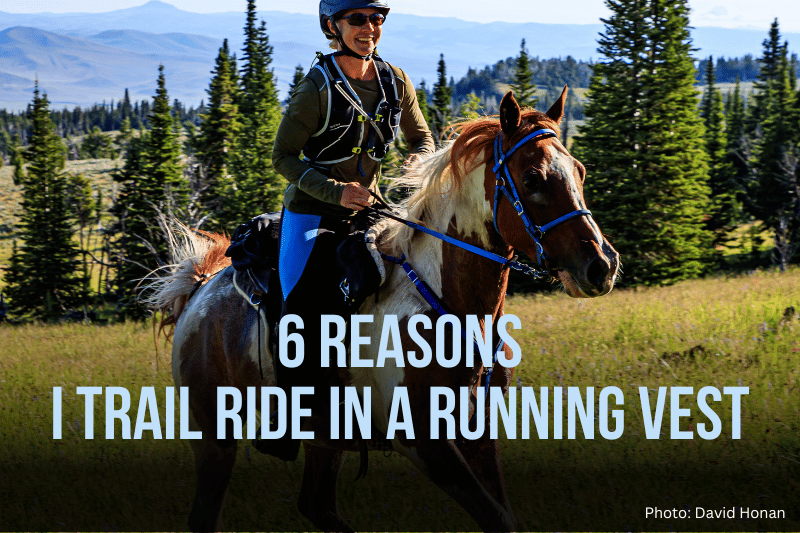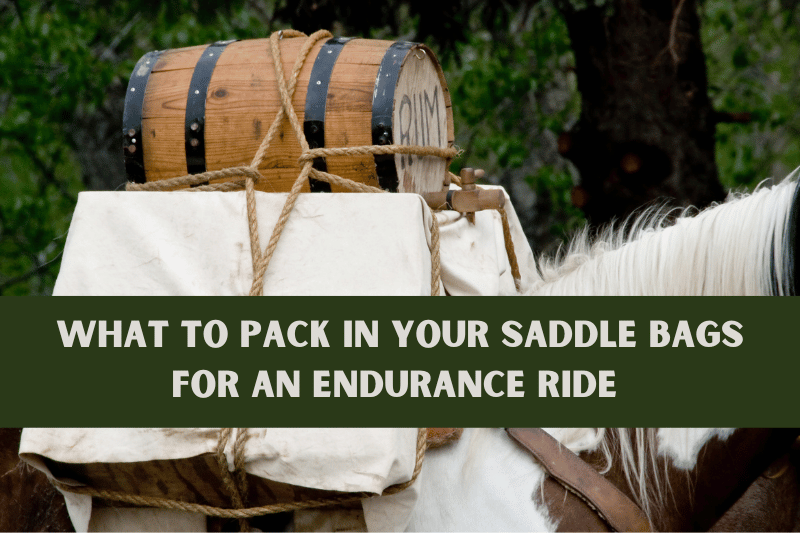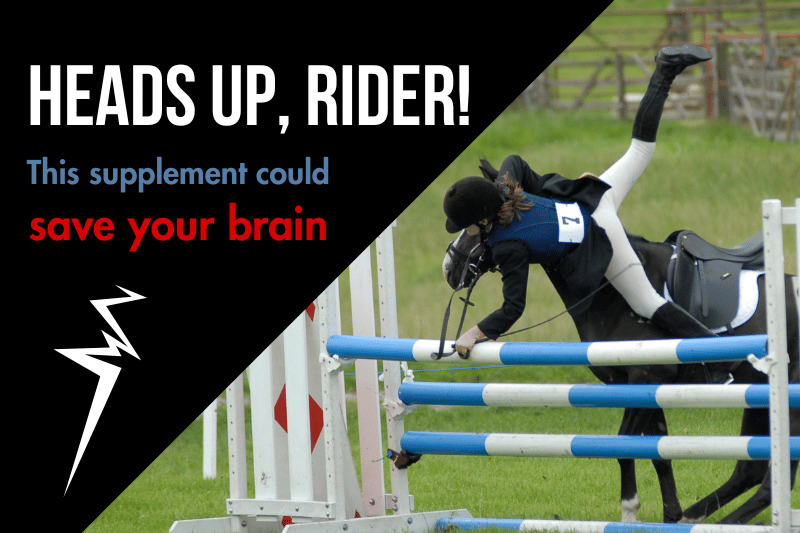Having the right trail riding gear can make or break the comfort and safety of your ride. We’ve all been told, “Keep your phone attached to your body, not your horse! That way, it’ll still be with you if you get dumped.”
Good advice. But is it good enough?
In this post, I’ll share six reasons I wear a running vest ~ not just a phone holster ~ on the trail.
Why I Trail Ride in a Running Vest
My story begins on the first really warm day of spring. I was twelve miles into a solo conditioning ride in the high desert near the Idaho-Oregon border. My mare was still fresh and snorty.
We trotted around a corner on an overgrown, dirt track between an irrigation canal and a steep bank. Up went a flock up ducks, all chaos and spray. My mare spun on the proverbial dime.
Unseated, I clung to her shoulder in that undignified position every rider knows, struggling to pull myself back into the saddle. I was pretty sure I’d make it…until my mare decided to leap up the bank. That maneuver shook me unceremoniously to the dirt.
Did my lovely mare stop to look apologetic? Oh no. No, she did not. She took off toward the trailer like her tail was on fire.
I dusted myself off and watched my well-stocked saddle bags flopping away down the trail. The sun felt suddenly hotter on my bare shoulders. I looked at my phone. It stared blankly back. No signal. Not for about 12 miles.
That was the moment I thought of a bunch of reasons to wear a running vest when I trail ride. I hope you’re discovering them now, from a more comfortable location.
1. A Running Vest is Made to Carry Water
If I could have kept one thing from my saddle bags that day, it would have been water. A person can get awfully thirsty during a 12-mile hike on an 80-degree day.
The primary purpose of a running vest is to serve as a hydration pack for athletes engaged in long, sweaty bouts of jostling movement. Running, sure, but why not riding?
Running vests typically have smaller bladders than hydration packs that are made for hiking or cycling – think 50 oz instead of 70 or 100. That’s a manageable quantity to carry comfortably, and it’s enough to make a hike out of a bad situation more bearable.
I still ride with water in my saddle bags. I drink that first, saving the water in my vest for an unplanned separation.
2. A Running Vest has Front Pockets
Running vests usually have two chest pockets. I carry my phone in one of them. This not only keeps my phone on my person; it also keeps it away from any bony parts that I’m likely to land on in a fall.
I once broke a pair of vertebrae (read the story here) when I came off a horse and landed on my lower back ~ right where my phone was riding in an SPI belt. I imagine a phone in one of those leg or arm holsters could leave quite a dent, too.
The other chest pocket of my running vest holds my InReach two-way satellite communication device. That would have been handy 12 miles from nowhere, without any cell service!
3. A Running Vest has Space for a Tiny Hike-Out Kit
As I trudged up the trail that spring day, I pondered the items that would be really nice to have. Besides water and my InReach, sunscreen was at the top of the list. And chapstick. And a snack.
Happily, these things fit in my running vest. I keep it stocked with a couple single-use sunscreen packets, Blistex medicated lip ointment (because it doesn’t melt), and some UCAN energy gels, which are easier on my stomach than the common shot-o-sugar variety.
I suppose a person could go crazy on emergency supplies: a knife, a whistle, chlorine tablets, and a foil blanket come to mind. Just remember, it’s all weight that you’ll carry often and use rarely. And, everything hard you put in the back of the pack is a potential “rock” waiting to crack a rib.
4. A Running Vest has Space for a Tiny First Aid Kit
I wasn’t hurt from that day’s fall, but I could have used some Band-Aids for blisters. I chose my riding boots for riding, not extended hikes!
My running vest now contains a few Band-Aids, plus a single-use pack of antibiotic ointment and a few doses of painkillers ranging from Advil to prescription leftovers from my last serious wreck. Each type of pill is in its own, tiny zip-top baggie with the drug name and dosing information noted in Sharpie.
Knock wood, I’ve never needed them.
If you take any time-sensitive, mission-critical prescriptions, you should probably carry a dose of that, too.
5. Running Vests are Comfortable
Running vests are designed specifically to be stable and minimally intrusive on a working athlete. They’re meant to be worn in any weather. Breathable fabrics make them tolerable in heat, and they’ll fit under a jacket when it’s cold.
My vest rides best when its bladder is about 75% full, which is enough water to get me out of most of my conditioning routes alive. If I’m really going far or starting a 25-mile loop on a summer endurance ride, I’ll top it off and live with the extra bulk.
Pro tip: If you find that a running vest rubs your neck on long rides, try wearing a shirt with a collar, like a polo shirt or blouse-style sun shirt.
6. Running Vests Let You Drink Hands-Free
Well, mostly hands-free. You might have to slip the little bite valve between your lips, but that’s a lot easier than messing around with bottles in zipped saddle bags.
Early in an endurance ride, when my hands are full of overexcited horse, this is the only way I’ll actually drink. It’s also the only time I break my rule about drinking the water on my person, not my saddle, first. I don’t worry about it because there are people around to assist if something goes wrong.
How to Choose Your Own Running Vest for Trail Riding
If you decide to buy one, I strongly recommend trying on a variety of running vests in person. A local running store or outdoor gear retailer should be able to help. If you’re on a budget, check your local sports consignment shop.
Running vests offer all sorts of different features and fits. Many are gender-specific, for obvious reasons, but you can choose whatever you prefer. As a small-chested person, I ride in a gender-neutral vest by Osprey. It covers more surface area than the vest I use for distance running, but has bigger front pockets to meet my riding needs.
Your new vest will come with a water bladder, and you may find that the drinking tube is much too long. Not to worry! You can remove the bite valve, slice the tube to your desired length with a decent kitchen knife, and slip the valve back on.
If you pick up a used vest but need a new water bladder, you can buy one separately. Be sure to look for the size and shape that’s meant to fit in the vest. Mixing and matching vest and bladder brands usually works fine, but pay attention to how the top of the bladder will attach to the inside of its pocket in the vest to make sure it’s compatible. You don’t want the bladder slouching down to the bottom of the pocket as you ride.
In Case You Were Wondering
What became of me on that unlucky spring day?
A pair of guys on ATVs saw my mare running loose and came looking for the body. They rescued me after I’d only hiked a few miles and zoomed me up the trail to catch my horse. She was a little lame, but recovered within a week.
In the meantime, I bought a running vest.
Hey, rider! If you got hurt on the trail, would first responders have the information they need? My free I.C.E. Pack includes printable placards for your stable and trailer, plus cards to carry on yourself and your horse. Get yours now.
This page may include affiliate links, and I may earn a small commission (at no extra cost to you) when you purchase through these links. I only recommend products and services I think are helpful and useful. Thanks for helping me offset the cost of maintaining this blog as a free resource!





All great reasons!
A note on the hands free drinking too, I have seen more riders pitched off their horse when fumbling to get a bottle out of a saddle bag than any scenario (think, you are bent forward or twisted around and in a vulnerable position if your horse stumbles or spooks). Having hands free drinking is hugely important beyond just getting ahead of your hydration early in the race.
One more thing I wanted to mention too and having read most of your posts I know you are onboard (this is for anyone reading who is now shopping for a running vest!), make sure to train your upper body when you work out especially if you are a first time vest wearer! I know a lot of equestrians neglect their upper body in workouts in favour of leg day, but keeping that extra weight is easier with strong shoulders and back, and a great posture!
Really good points, Sarah!! Some planking, bird dogs, rows, and overhead presses would be excellent for getting that upper body ready to handle a little extra weight for a long period of time.